#programmatic architecture
Explore tagged Tumblr posts
Text
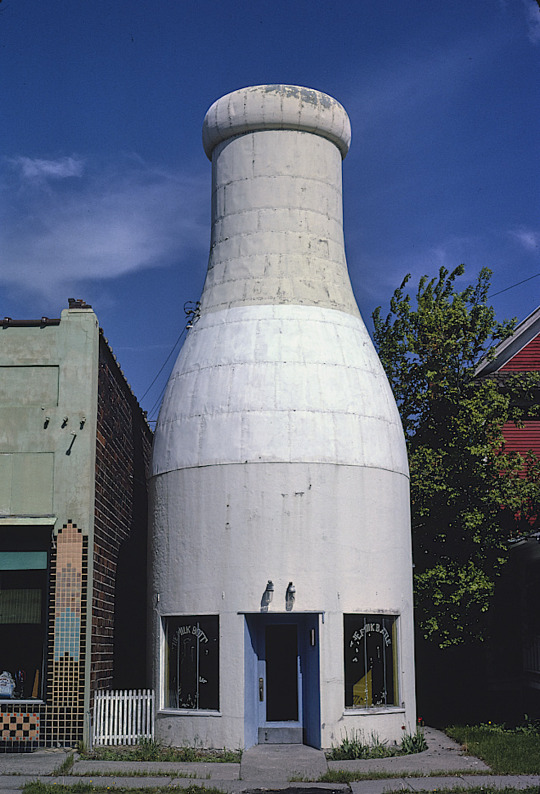
Milk bottle store. Cedar St., Spokane, Washington. John Margolies, photographer, 1980.
LOC
#programmatic architecture#roadside architecture#whimsy#milk bottle#spokane#john margolies#1980#1980s#color photography#1k
6K notes
·
View notes
Text

randy's donuts. inglewood, calif. april 2025
© tag christof
#tag christof#america is dead#on the road#programmatic architecture#vernacular#donut#los angeles#leica SL2#voigtlander
130 notes
·
View notes
Text
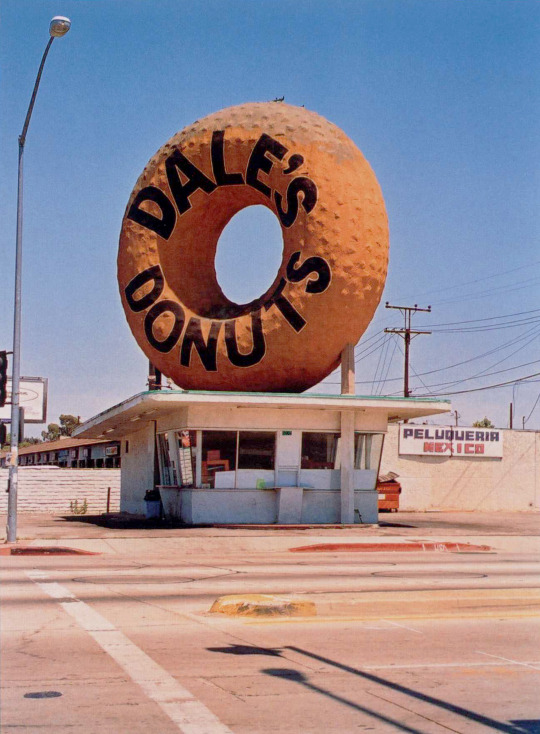
Dale's Donuts, Compton, California, Photograph: Nathan Marsak
#programmatic architecture#architecture#design#art#architecture parlante#dale's donuts#Compton#LA#California#Nathan Marsak#photography#donut#donuts
358 notes
·
View notes
Text
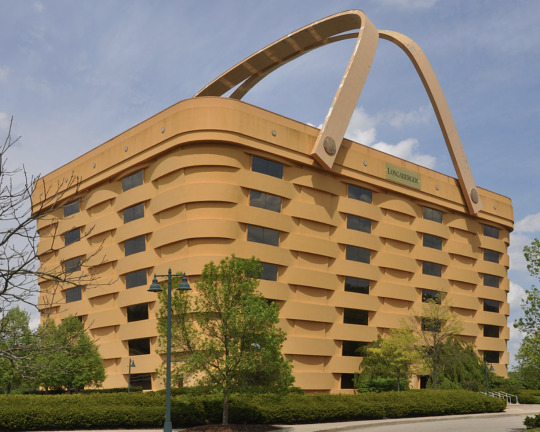
꧁★꧂
#picnic basket#picnic#basket#office building#programmatic architecture#roadside attraction#roadside america#newark#ohio#longaberger building#flickr#oldweb#old web#2012
213 notes
·
View notes
Text

Big Donut Drive-In
Los Angeles, California
-
After donut machine salesman Russell C. Wendell launched his Big Donut chain in 1949, he subsequently built 10 locations in and around Los Angeles. Some were taller than 30 feet.
Source: https://www.architecturaldigest.com/story/west-coast-programmatic-architecture
-
#doughnuts#whimsical architecture#novelty architecture#americana#roadside america#kitsch#programmatic architecture
4 notes
·
View notes
Text
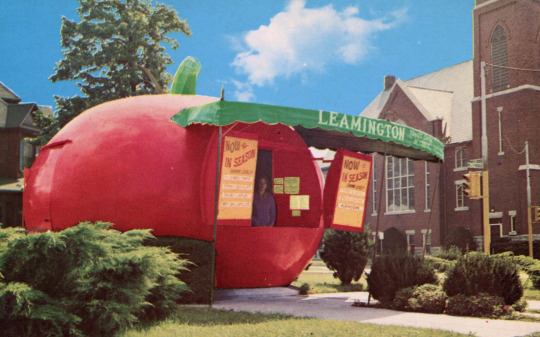
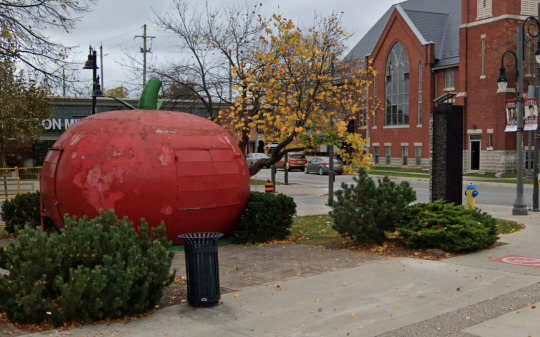

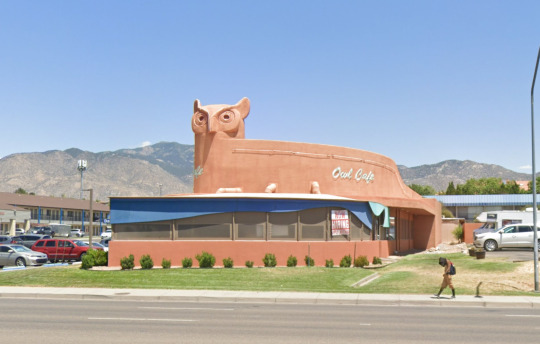
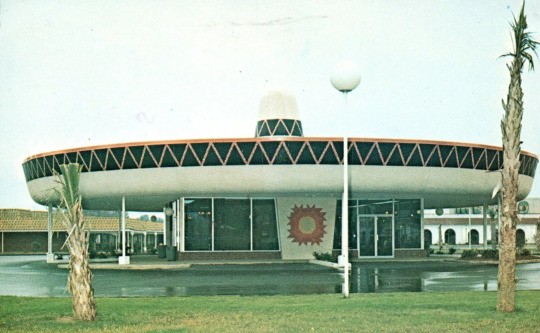

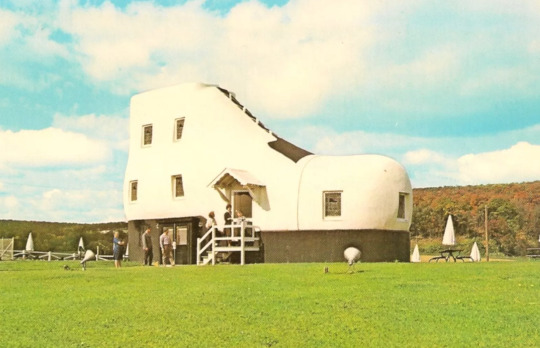

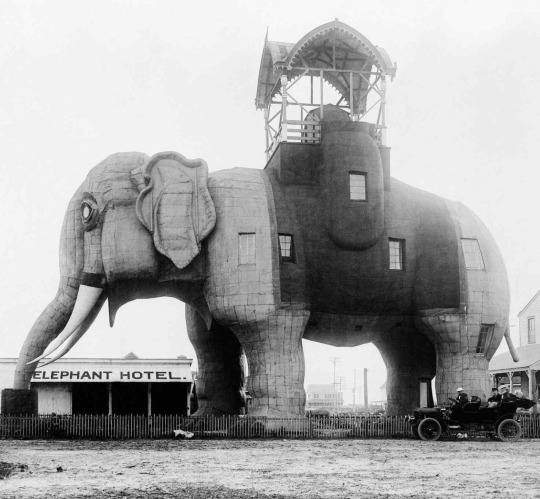
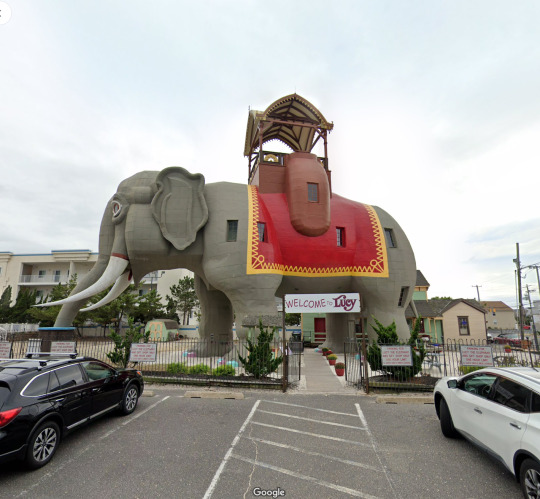

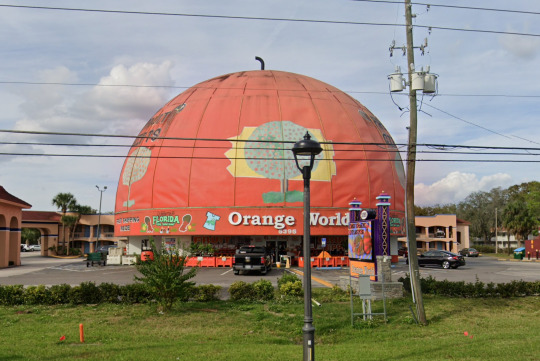


Novelty architecture: a type of building in which structures are designed as familiar shapes such as characters, animals, food, clothing items or household objects. Each one is usually kitschy, gaudy, and eye-catching. This style is also known as ‘mimetic,’ ‘programmatic’ or 'duck' architecture.
Leamington, Ontario's big tomato, circa 1961, is a classic example of this type of building. While it served as a tourist information booth for six decades, water damage and mold forced it to close in 2019. For 5 years, it sat deteriorating. In 2024, the Leamington council approved a restoration project, stating that the tomato is “representation of the area’s rich history and culture." The tomato's days are not over yet.
I've included a few more then + now views of novelty architecture: An owl cafe in New Mexico, a sombrero restaurant in South Carolina, a shoe house in Pennsylvania, an elephant in New Jersey, a big orange in Florida and an airplane-gas-station in Tennessee. Each of these buildings are alive, well and open for business. Most, if not all, have had ongoing restoration efforts and have all been lovingly cared for over the years.
3K notes
·
View notes
Text
StreamBuilder: our open-source framework for powering your dashboard.
Today, we’re abnormally jazzed to announce that we’re open-sourcing the custom framework we built to power your dashboard on Tumblr. We call it StreamBuilder, and we’ve been using it for many years.
First things first. What is open-sourcing? Open sourcing is a decentralized software development model that encourages open collaboration. In more accessible language, it is any program whose source code is made available for use or modification as users or other developers see fit.
What, then, is StreamBuilder? Well, every time you hit your Following feed, or For You, or search results, a blog’s posts, a list of tagged posts, or even check out blog recommendations, you’re using this framework under the hood. If you want to dive into the code, check it out here on GitHub!
StreamBuilder has a lot going on. The primary architecture centers around “streams” of content: whether posts from a blog, a list of blogs you’re following, posts using a specific tag, or posts relating to a search. These are separate kinds of streams, which can be mixed together, filtered based on certain criteria, ranked for relevancy or engagement likelihood, and more.
On your Tumblr dashboard today you can see how there are posts from blogs you follow, mixed with posts from tags you follow, mixed with blog recommendations. Each of those is a separate stream, with its own logic, but sharing this same framework. We inject those recommendations at certain intervals, filter posts based on who you’re blocking, and rank the posts for relevancy if you have “Best stuff first” enabled. Those are all examples of the functionality StreamBuilder affords for us.
So, what’s included in the box?
The full framework library of code that we use today, on Tumblr, to power almost every feed of content you see on the platform.
A YAML syntax for composing streams of content, and how to filter, inject, and rank them.
Abstractions for programmatically composing, filtering, ranking, injecting, and debugging streams.
Abstractions for composing streams together—such as with carousels, for streams-within-streams.
An abstraction for cursor-based pagination for complex stream templates.
Unit tests covering the public interface for the library and most of the underlying code.
What’s still to come
Documentation. We have a lot to migrate from our own internal tools and put in here!
More example stream templates and example implementations of different common streams.
If you have questions, please check out the code and file an issue there.
5K notes
·
View notes
Text
The so-called Department of Government Efficiency (DOGE) is starting to put together a team to migrate the Social Security Administration’s (SSA) computer systems entirely off one of its oldest programming languages in a matter of months, potentially putting the integrity of the system—and the benefits on which tens of millions of Americans rely—at risk.
The project is being organized by Elon Musk lieutenant Steve Davis, multiple sources who were not given permission to talk to the media tell WIRED, and aims to migrate all SSA systems off COBOL, one of the first common business-oriented programming languages, and onto a more modern replacement like Java within a scheduled tight timeframe of a few months.
Under any circumstances, a migration of this size and scale would be a massive undertaking, experts tell WIRED, but the expedited deadline runs the risk of obstructing payments to the more than 65 million people in the US currently receiving Social Security benefits.
“Of course, one of the big risks is not underpayment or overpayment per se; [it’s also] not paying someone at all and not knowing about it. The invisible errors and omissions,” an SSA technologist tells WIRED.
The Social Security Administration did not immediately reply to WIRED’s request for comment.
SSA has been under increasing scrutiny from president Donald Trump’s administration. In February, Musk took aim at SSA, falsely claiming that the agency was rife with fraud. Specifically, Musk pointed to data he allegedly pulled from the system that showed 150-year-olds in the US were receiving benefits, something that isn’t actually happening. Over the last few weeks, following significant cuts to the agency by DOGE, SSA has suffered frequent website crashes and long wait times over the phone, The Washington Post reported this week.
This proposed migration isn’t the first time SSA has tried to move away from COBOL: In 2017, SSA announced a plan to receive hundreds of millions in funding to replace its core systems. The agency predicted that it would take around five years to modernize these systems. Because of the coronavirus pandemic in 2020, the agency pivoted away from this work to focus on more public-facing projects.
Like many legacy government IT systems, SSA systems contain code written in COBOL, a programming language created in part in the 1950s by computing pioneer Grace Hopper. The Defense Department essentially pressured private industry to use COBOL soon after its creation, spurring widespread adoption and making it one of the most widely used languages for mainframes, or computer systems that process and store large amounts of data quickly, by the 1970s. (At least one DOD-related website praising Hopper's accomplishments is no longer active, likely following the Trump administration’s DEI purge of military acknowledgements.)
As recently as 2016, SSA’s infrastructure contained more than 60 million lines of code written in COBOL, with millions more written in other legacy coding languages, the agency’s Office of the Inspector General found. In fact, SSA’s core programmatic systems and architecture haven’t been “substantially” updated since the 1980s when the agency developed its own database system called MADAM, or the Master Data Access Method, which was written in COBOL and Assembler, according to SSA’s 2017 modernization plan.
SSA’s core “logic” is also written largely in COBOL. This is the code that issues social security numbers, manages payments, and even calculates the total amount beneficiaries should receive for different services, a former senior SSA technologist who worked in the office of the chief information officer says. Even minor changes could result in cascading failures across programs.
“If you weren't worried about a whole bunch of people not getting benefits or getting the wrong benefits, or getting the wrong entitlements, or having to wait ages, then sure go ahead,” says Dan Hon, principal of Very Little Gravitas, a technology strategy consultancy that helps government modernize services, about completing such a migration in a short timeframe.
It’s unclear when exactly the code migration would start. A recent document circulated amongst SSA staff laying out the agency’s priorities through May does not mention it, instead naming other priorities like terminating “non-essential contracts” and adopting artificial intelligence to “augment” administrative and technical writing.
Earlier this month, WIRED reported that at least 10 DOGE operatives were currently working within SSA, including a number of young and inexperienced engineers like Luke Farritor and Ethan Shaotran. At the time, sources told WIRED that the DOGE operatives would focus on how people identify themselves to access their benefits online.
Sources within SSA expect the project to begin in earnest once DOGE identifies and marks remaining beneficiaries as deceased and connecting disparate agency databases. In a Thursday morning court filing, an affidavit from SSA acting administrator Leland Dudek said that at least two DOGE operatives are currently working on a project formally called the “Are You Alive Project,” targeting what these operatives believe to be improper payments and fraud within the agency’s system by calling individual beneficiaries. The agency is currently battling for sweeping access to SSA’s systems in court to finish this work. (Again, 150-year-olds are not collecting social security benefits. That specific age was likely a quirk of COBOL. It doesn’t include a date type, so dates are often coded to a specific reference point—May 20, 1875, the date of an international standards-setting conference held in Paris, known as the Convention du Mètre.)
In order to migrate all COBOL code into a more modern language within a few months, DOGE would likely need to employ some form of generative artificial intelligence to help translate the millions of lines of code, sources tell WIRED. “DOGE thinks if they can say they got rid of all the COBOL in months, then their way is the right way, and we all just suck for not breaking shit,” says the SSA technologist.
DOGE would also need to develop tests to ensure the new system’s outputs match the previous one. It would be difficult to resolve all of the possible edge cases over the course of several years, let alone months, adds the SSA technologist.
“This is an environment that is held together with bail wire and duct tape,” the former senior SSA technologist working in the office of the chief information officer tells WIRED. “The leaders need to understand that they’re dealing with a house of cards or Jenga. If they start pulling pieces out, which they’ve already stated they’re doing, things can break.”
260 notes
·
View notes
Text
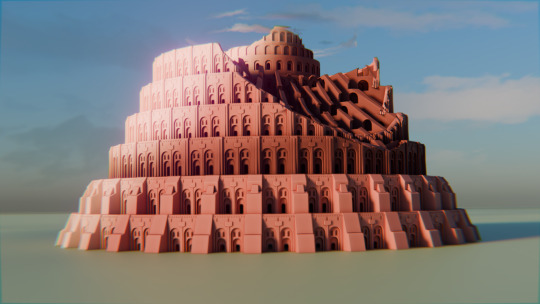

Returning to blender with something comfortable, a new iteration of my neoclassical building generation tool(s). the idea of these tools is to use geonodes to handle the repetitive aspects of the design, usually by designing a single feature (here an arch, and some pillars) and then arranging them programmatically.
the ultimate goal would be something which could quickly make new designs based on changing simple parameters or source features, but for now the node trees need re-tuning for each new design
This building is based on Bruegel's Tower of Babel paintings, possibly the earliest example of dream/fantasy architecture in art
38 notes
·
View notes
Text


His depictions of industrial and technology-related objects count among the most significant contributions to German New Objectivity but still his name is far lesser known than those of his peers: the talk is of Carl Grossberg (1894-1940), a former architecture student, Bauhaus disciple and a pupil of Lyonel Feininger. Likely motivated by the latter’s example Grossberg in the early 1920s painted intricate townscapes nevertheless far from Feininger’s cubist-expressionist example: their colorful, building brick-like volumes markedly differ from Feininger's prismatic, upwards zooming paintings. In the following years Grossberg’s townscapes gradually become more detailed and from 1925 onwards he in parallel developed the so-called „Traumbilder“, visions of surreal architectural constellations, reminiscent of Giorgio de Chirico, combined with animals, plants or machines.
His growing interest in technology and technical objects in 1927 ultimately made its way to the canvas, namely in the form of three paintings of Cologne Main Station, a modern bridge in Wuppertal and another „Traumbild“. They paved the way for Grossberg’s famous depictions of industrial facilities and machineries that he first painted in 1933. With photographic precision Grossberg joins different strands of his previous paintings in a new, sharp pictorial language. In doing so Grossberg acknowledges the wealth of forms and shapes introduced by the processing industry and in a programmatic text also seeks to distance himself from his peers whom he regards as being stuck in „green fields and cows“.
Unfortunately there is little interest in his paintings in the circles of potential buyers and Grossberg gradually sinks into pessimism as Hans-Werner Schmidt recounts in his excellent essay included in the present catalogue: it was published alongside a retrospective at Von-der-Heydt-Museum Wuppertal in 1994 by DuMont and to this day remains the sole comprehensive publication on the artist. It features a large number of paintings, watercolors and drawings as well as insightful essays, e.g. by the painter’s daughter Eva who provides insights into her father’s life and personality. Highly recommended!
#carl grossberg#neue sachlichkeit#art book#exhibition catalogue#modern art#new objectivity#art history#book
17 notes
·
View notes
Text





THE BIGGEST BITE IN THE MONSTROUS BURGER HISTORY OF CLASSIC, VINTAGE LOS ANGELES.
PIC(S) INFO: Mega spotlight on “The Burger That Ate L.A," a now legendary and world famous burger joint on Melrose Ave. in the shape of a giant cheeseburger. "This amazing attempt at wackiness was designed by Solberg and Lowe Architects and created by owner David Alderman. "
MINI-OVERVIEW: "We all know that programmatic architecture in Los Angeles was very popular in the 1920s and 1930s, but here’s an example of a programmatic structure, during the 1980s and 1990s… The Burger That Ate L.A. was a latecomer in Los Angeles' venerable pantheon of fantasy architecture. It ranked up there with Randy's Donuts and Tail o' the Pup.
The Burger That Ate L.A. held its own on trendy Melrose Ave. The bun-shaped dome once devoured the corner of Stanley Avenue. The unconventional facade (with sesame seeds) was shaped like a giant cheeseburger had glass bricks forming as ketchup and oozing with onions. The structure also appeared to have a missing bite chomping on City Hall."
-- ALISON MARTINO'S "Vintage Los Angeles," "The Burger That Ate L.A.," published June 15, 2024
Source: http://martinostimemachine.blogspot.com/2024/06/the-burger-that-ate-la.html.
#The Burger That Ate L.A.#Vintage Los Angeles#Vintage L.A.#Vintage Style#L.A. Style#L.A.#Los Angeles#Burger Joint#Vintage Restaurants#Giant Cheeseburger#80s L.A.#Melrose Ave#American Style#Melrose Avenue#Retro L.A.#1980s#80s#Giant Cheeseburger Architecture#Cheeseburgers#American Diners#80s Style#L.A. Architecture#Americana#Burger Joints#Wacky Architecture#Burgers#Vintage Menu#Hamburgers#Los Angeles CA#Vintage Menus
5 notes
·
View notes
Text
the mean hemisphere of my brain is always like it would be really awesome if people understood the basic technical architecture underpinning common internet shit so they could make more useful critiques of said internet shit but the less mean hemisphere of my brain is like okay I've been working adjacent to the ads industry for the last five years or so and literally just today I bought a "programmatic for idiot crybabies" book because I still get confused about certain topics. that said I feel like basic familiarity with ad auctions should be common knowledge but maybe I'm just being xkcd-2501 about it
52 notes
·
View notes
Text
The rationalisation of space under capitalism is one facet of the ideology of progress which has had a profound impact on the spatial organisation of society in nature. Marxist geographer David Harvey writes that ‘capital accumulation and the production of urbanisation go hand in hand’. For Harvey, urbanisation is a physical manifestation of the drive to produce a ‘rational landscape’ in which barriers to the turnover time of capital accumulation are removed. In this sense then, letting space lie fallow introduced unacceptable friction into the capitalist system. Highlighting this shift, urban and environmental geographer Matthew Gandy notes that ‘the very idea of rest, and of resting space in particular – letting the earth sleep – counters the accelerative and all-encompassing momentum of late modernity’. The incongruity, however, isn’t just a question of an anxious space of late modernity. The instrumentalisation of space is already apparent in the mid-19th century, when Ildefons Cerdà’s opening statement for urbanisation sought to ‘fill the earth’. And by the early 20th century, this programmatic vision for design was fully institutionalised when Ebenezer Howard’s seminal Garden Cities project ‘sought to maximise functionality through territory saturated with activity’.
Time is also rationalised and subsumed under the growth imperative, which legitimates practices used to force people into reconfigured social relations. As critical urban theorist Alvaro Sevilla-Buitrago remarks, for example, ‘improvers couldn’t stand idleness, regardless of whether it referred to a quality of land or to poor commoners “wasting” productive time by contemplating their grazing livestock instead of embracing wage discipline as day labourers’. It was the capitalist project to proletarianise the population that transformed social relations connected more with ecological rhythms into the realm of the abstract rhythms of capitalism. Put another way, wresting productivity from humans – and non-humans – through labour discipline has always been a central feature of the project of capitalism, from the Enclosure Acts in England until today. Capturing ‘wasted time’ also had another social dimension: the production of new forms of citizenship meant to underpin the bourgeois vision of the modern metropolis. In New York City, for example, Sevilla-Buitrago interprets the construction of Central Park as a ‘special kind of enclosure … [that was meant to] shift behaviors from one regime of publicity to another’ in a battle that pitted the elite against the commoning practices of the New York City streetscape by recently arrived immigrants. While geographer Tony Weis has shown that the slow rhythms and periodic pauses of fallowing can influence social organisation in potentially progressive ways, we see above that the devaluation of idleness has instead promoted a capitalist subject synchronised to the rhythms of capitalist time.
Taken as a whole, the move to valuing progress over fallowing signalled a regime change that rationalised space and time, which, in turn, produced radical social, ecological and continuous urban transformations that, today, are felt on a planetary scale. Viewing the planet as a kind of perpetual growth machine with a core purpose of chasing profits, an ever-growing metabolism, is churning the earth in successive waves of creative destruction. This results in both acute and chronic pathologies of devalued human social relations, diminished diversity of the biosphere and a continually transformed urban fabric at ever larger scales. What impact has the growth imperative had on the design professions? Embedded in, and arguably a tool of, capital, the design professions have been criticised as largely geared towards solving the problems of wasted space to restore class relations and processes of accumulation. Can a design culture that sees itself as inextricably linked to growth retrain its analytical lens on social and ecological value production that exists outside capitalist sociospatial relations, rather than viewing moments of inactivity merely as opportunities to promote the next growth cycle?
68 notes
·
View notes
Text

Hoot Owl Cafe, Long Beach, California, 1926
#architecture#hoot owl cafe#owl#Long Beach#california#art#design#photography#black and white#architecture parlante#programmatic architecture#object
115 notes
·
View notes
Text
The Snowman Who Danced and Died: A Reflective Essay on Erich Wolfgang Korngold’s Der Schneemann

I. Musical Architecture in a Child’s Hand: A Technical Analysis of Structure and Texture
Though composed by Erich Wolfgang Korngold at the astonishing age of 11, Der Schneemann (The Snowman) is not a mere juvenile curiosity. Structurally, the piece reflects a nascent mastery of form, motivic development, and a particularly refined approach to orchestration that anticipates Korngold’s later operatic and cinematic triumphs. Despite its format as a ballet-pantomime, the work unfolds with the logic and cohesion of a symphonic tone poem, shaped by dramatic intent and sophisticated harmonic language.
Form and Narrative Architecture
Der Schneemann follows a ternary macro-structure (A–B–A′) with embedded episodes, functioning somewhat like a programmatic suite but with fluid transitions rather than clear-cut movements. The opening "A" section introduces the thematic material—a bright, scampering dance for the snowman, presented in 6/8 time and centered around G major, which functions as a psychological “home key” of innocence and magic.
This theme is structurally polythematic rather than monothematic, with two secondary ideas appearing in quick succession: a lyrical rising motif in the oboe and flute, and a syncopated descending figure in the clarinet, possibly representing the children’s anticipation. These themes are organically developed throughout the piece via fragmentation, sequence, and re-orchestration.
The central “B” section (often referred to as the dramatic core of the ballet) modulates through chromatic mediants—from G major to B♭ minor, then D♭ major, and E minor—employing enharmonic pivots rather than traditional dominant relationships. This harmonic scheme is strikingly advanced, relying on non-functional chromaticism that prefigures Korngold’s late-Romantic modernism. In this section, contrapuntal textures and expanded instrumentation appear, including divisi strings, muted trombones, and celesta interjections that create a surreal and shadowed environment.
The return of the "A′" section is not a literal recapitulation but a transformed reappearance of earlier material, now tinged with nostalgia and decay. The snowman’s theme returns in E minor—the distant relative of G major—and is harmonized with dissonant extensions (minor ninths, diminished sevenths) that signal his impending demise. This manipulation of motivic contour combined with modal inflection is one of the most remarkable features of the piece.
Motivic Development and Transformation
Korngold’s early use of leitmotivic technique is nothing short of remarkable. The snowman’s theme, a staccato dotted-rhythm figure ascending a minor sixth and falling a fourth, is a quasi-scherzando motive first stated in the violins and later presented in woodwinds and brass. Over time, this motive is:
Inverted (melodic shape reversed) in the bassoons and horns
Augmented rhythmically (doubled note values) during the snowman’s dance
Dissolved into descending chromatic fragments at his melting, mimicking physical disintegration
The children’s theme, on the other hand, remains mostly diatonic and rhythmically regular—serving as a stabilizing anchor against the snowman’s increasing harmonic volatility.
Notably, there’s an unstated third motive associated with time and entropy—perhaps not a theme in the melodic sense, but a recurring harmonic gesture: descending whole-tone chords (frequently in the strings) that disrupt thematic clarity. This anticipates Korngold’s use of harmonic foreshadowing in his later operas such as Die tote Stadt.
Orchestration and Timbre as Dramatic Function
The orchestration of Der Schneemann is not just decorative—it is narratively integral. Korngold assigns thematic material to specific instrumental families, reinforcing character and scene. The snowman’s entrance, for example, is scored with glissandi harp, celesta, and muted high strings, creating a glittering aural frost. The antagonist’s material—heavily brassy, clustered in low registers—utilizes quartal harmonies and parallel minor triads for a threatening presence.
The composer also exhibits early understanding of Klangfarbenmelodie—the technique of passing a melodic line across different instruments for coloristic variety. This is especially evident in the snowman’s farewell, where a plaintive variation of the main theme is handed from English horn to solo violin to horn, each adding an emotional shade.
Dynamic contours are finely sculpted: sudden subito pianos, terraced crescendos, and textural thinning align perfectly with shifts in mood and choreography. Korngold even employs metric displacement (e.g., accenting off-beats in 6/8 to create metric ambiguity), especially in transitional passages where magical or uncanny effects are desired.
II. A Frosted Tale: Romanticism in a Melting World
At its heart, Der Schneemann is a tender narrative about innocence, imagination, and impermanence. The storyline—two children build a snowman who magically comes to life, dances joyously, and then melts—is deceptively simple. But through Korngold’s music, it acquires the emotional weight of a miniature Romantic tragedy.
The snowman is not just a whimsical figure but a projection of the children’s dreams, a totem of joy conjured by belief. His vitality, defined musically by shimmering textures and infectious dance rhythms, is ultimately unsustainable. His death is not violent but inevitable, as natural as the changing of seasons. The melting—portrayed with descending chromaticism and thinning orchestration—becomes a poignant metaphor for transience itself.
There is a deep sense of loss, even grief, in the final bars—not just for the children, but for the ephemeral beauty the snowman represented. This aligns Korngold’s tale with the broader fin-de-siècle aesthetic, where beauty is often fleeting, and magic is tinged with melancholy. The emotional arc feels distinctly Romantic, despite its brevity and youthful origins: joy, wonder, loss, and the quiet persistence of memory.
III. A Legacy in a Snowdrift: Rediscovery and Relevance
Der Schneemann enjoyed immediate success when premiered in Vienna in 1910, and it helped propel Korngold into the spotlight, gaining the endorsement of Gustav Mahler himself. Yet today, it remains overshadowed by his later operas (Die tote Stadt, Violanta) and his influential film scores (The Adventures of Robin Hood, King’s Row).
The piece's relative obscurity may be due to its unusual form—a ballet-pantomime too short for a full evening, too intricate for casual performance. But as modern audiences re-evaluate early 20th-century composers beyond the dominant modernist narrative, Der Schneemann has begun to reclaim its place as a remarkable early work by a prodigious voice. It exemplifies the transitional moment between Romanticism and modernity, Viennese sweetness and psychological disquiet.
In a cultural climate increasingly attuned to themes of impermanence, nostalgia, and the innocence of childhood, Korngold’s snowman speaks again. His joyful dance and inevitable melting feel oddly prescient—a symbol not only of fleeting wonder, but of art’s ability to freeze, however briefly, the warmth of human imagination in the coldest hour.
youtube
2 notes
·
View notes
Text

The Brown Derby
Hollywood, California
Photo source: instagram @_charlesphoenix
-
#brown derby#programmatic architecture#americana#roadside america#whimsical architecture#novelty architecture#kitsch
1 note
·
View note